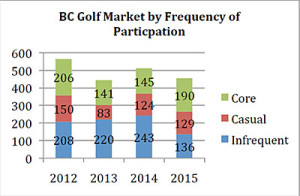by Matthew Steinbach – Manager, Golf Participation, British Columbia Golf
In my first two months as Golf Participation Manager at British Columbia Golf, I have reviewed an array of survey data and information relating to golf participation in the province, in Canada, and in the United States. While many reports focus on the common thread of “what is wrong with the game” – golf is too expensive, takes too much time, and is too difficult – I have found that there’s a lot of positive momentum.
Overall, participation numbers in British Columbia have increased each of the last two years, rebounding from a low in 2013. Much of this growth in largely attributed to the “Core” and “Casual” Golfers.
What is concerning is the number of “Infrequent” players reaching a low in 2015. In this case, a greater number of “infrequent” players are leaving the game (or graduating to casual/core) than are joining the game. Much of the “infrequent” decline is sourced to Female participation. Conversely, participation on the “core” group has increased for both Males and Females. With the majority of “core” golfers belonging to the ‘Boomer’ generation, measures need to be taken to ensure they remain energized to play the game fifteen years from now.
Through the data and various sources, I have identified four key groups where I believe special attention should be focused.
- Energize Core Golfers
- Engage Women in Golf
- Encourage Youth Recreation
- Entice Millennials
This will not be new for many who are current with the trends in golf participation. Rather, my summary will highlight the amount of work that is required among all industry partners to maintain and grow participation in golf. Each of these groups shares great opportunities and challenges.
Some, like the “Core Golfers” may require less direct energy in the short term but could present a bigger risk in the long term. Others, like the ‘Millennial’ group will most likely require high amounts of input and energy in both the short term and long term.Their potential, however, cannot be overlooked as they are the largest demographic to grow golf participation.
Energize Core Golfers
Energize: to give energy or excitement to (someone or something)
In the short term, Core golfers require less work and investment to maintain participation. They understand how the game is played and have foundational golf skills; they own equipment and memberships; they have social connections and regular outings planned. The opportunity is to increase their number of rounds played.
In the long term, with many from the Core group belonging to the Boomer generation, concerted efforts will be needed to keep the aging population energized to play the game. Concerns with mobility, physical accessibility, and connection with the game will need to be addressed.
Strategies should be developed to address the aging population to ensure they’re supported in accessing and playing golf. As this older generation loses their social sphere, how can we encourage them to give back to the younger generations and become volunteers, aides, and mentors?
Engage Women in Golf
Engage: to get and keep (someone’s attention, interest, etc.)
For the purpose of growing Female participation, efforts need to be focused on breaking down the stereotypes and building awareness of the positive aspects of golf. A unified voice needs to (re)introduce that golf is Fun, Non-intimidating, and welcoming. More importantly, the actions amongst the golf industry partners need to reinforce the same message.
There are many great programs already in place to engage women in golf, like Get Golf Ready, Women’s Golf Day, Future Links Jr. Girls Club, Women with Drive, etc. As an industry we need to raise the awareness of these programs – a shared message, that indicates that golf is a great avenue to build relationships and create connections:
- Women’s only leagues & Clubs
- Business and networking opportunities
- Family time – spouse, parents, kids
Encourage Youth Recreation
Encourage: to make (someone) more determined, hopeful, or confident
Introducing the game of golf to youth is a foundational commitment needed to ensure a healthy group of new participants. There are many extraordinary examples of strong programs in place to introduce the game. Some of the programs with highest awareness are in the junior golf stream: Take a Kid to the Course, Canucks Junior Golf Week, Future Links, etc.
Strong youth development can also be found in local and regional pockets – from junior programs of +200 at Marine Drive, to City-wide initiatives in school and at facilities in Burnaby. At the same time, there are other Provincial and National programs that have widespread reach to introduce the game specifically through school programs like Playground to Fairway and Golf in Schools.
From a development standpoint, the focus of youth golf quickly moves into the competitive stream soon after these introductory programs, leaving a void for youth participation on the recreational side.
A few key themes emerged from the survey results, indicating areas that should be addressed. One large area was an overwhelming lack of awareness for most of these programs – specifically the various School Golf Programs. Facilities were not aware that the programs existed or how to access these programs, although they did express interest in learning more.
A second theme indicated that there was a lack of alignment among golf bodies – too many programs available and competing against each other. My recommendation is twofold along these themes. One, we need alignment among program offerings and consistency with delivery and two; we need to bring awareness to these programs with a unified message.
The future growth will depend on introducing youth to the game of golf. We need to adopt a “recreational” mindset with respect to youth participation especially as we look to replace the ‘Boomer’ generation. Seeds need to be planted now and youth needs to be encouraged to ensure future growth.
Entice Millennials
Entice: to attract (someone) especially by offering or showing something that is appealing, interesting, etc.
Everyone is trying to figure out how to “tap into Millennials”. They are now the largest demographic population having surpassed the Boomers. They are sometimes seen as narcissistic and disengaged from society. Other times, they are the catalysts for growth and change.
As a Millennial myself, I warn about casting broad strokes and generalizing such a complex group. With that said, they (we) are an appealing demographic. Much energy and effort is required to encourage golf participation through a targeted and specific plan to introduce and entice playing the game. A long term strategy is required, but we must remain reactive and adaptive to change.
The biggest driver to grow participation amongst Millennials will be to tap into the cost/value proposition. This includes breaking down old perceptions and being receptive to:
- Adaptive Golf: footgolf, disc golf, speed golf
- Alternative Venues: ‘Top Golf’ Driving Ranges, Golf Simulators
- Alternative Equipment: Golf Boards, Golf Bikes, Golf Carts, Hover Carts
- Lifestyle: music on course, digital technology, connectivity
- Dress code: Streetwear, casual wear, beachwear
Overall, efforts are being made from all industries to capture the Millennial population. For golf, I feel we need to answer the question: What else am I getting from golf? What is Golf 2.0?
Conclusion
In order to develop strategies for long term growth, partners must commit to long term collaboration and resist the temptation for easier short term gains. The overall health of golf participation in the long term is dependent on a unified voice among partners bringing awareness to the opportunities available to the public. There is already much great work being done to encourage golf participation. Various National and Provincial programs have reached new golfers and brought awareness.
What I see as the biggest challenge (and opportunity) is for the collective partners to support each rather than competing against each other. We need to engage with the public and breakdown the perceived barriers for entry. We need to make it easier for the consumer (the golfer) and encourage them to enter the game. We need to entice participation through a strong cost/value proposition. And we need to keep the core golfers energized and wanting to return and play more.







